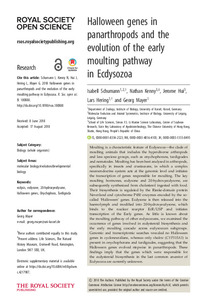Aufsatz

Halloween genes in panarthropods and the evolution of the early moulting pathway in Ecdysozoa
Zusammenfassung
Moulting is a characteristic feature of Ecdysozoa—the clade of moulting animals that includes the hyperdiverse arthropods and less speciose groups, such as onychophorans, tardigrades and nematodes. Moulting has been best analysed in arthropods, specifically in insects and crustaceans, in which a complex neuroendocrine system acts at the genomic level and initiates the transcription of genes responsible for moulting. The key moulting hormones, ecdysone and 20-hydroxyecdysone, are subsequently synthesized from cholesterol ingested with food. Their biosynthesis is regulated by the Rieske-domain protein Neverland and cytochrome P450 enzymes encoded by the so-called ‘Halloween’ genes. Ecdysone is then released into the haemolymph and modified into 20-hydroxyecdysone, which binds to the nuclear receptor EcR/USP and initiates transcription of the Early genes. As little is known about the moulting pathway of other ecdysozoans, we examined the occurrence of genes involved in ecdysteroid biosynthesis and the early moulting cascade across ecdysozoan subgroups. Genomic and transcriptomic searches revealed no Halloween genes in cycloneuralians, whereas only shadow (CYP315A1) is present in onychophorans and tardigrades, suggesting that the Halloween genes evolved stepwise in panarthropods. These findings imply that the genes which were responsible for the ecdysteroid biosynthesis in the last common ancestor of Ecdysozoa are currently unknown.
Zitierform
In: Royal Society Open Science 2018 / 5 (2018-09-01) , S. 180888 ; ISSN: 2054-5703Förderhinweis
Gefördert durch den Publikationsfonds der Universität KasselZitieren
@article{doi:10.17170/kobra-20190130123,
author={Schumann, Isabell and Kenny, Nathan and Hui, Jerome and Hering, Lars and Mayer, Georg},
title={Halloween genes in panarthropods and the evolution of the early moulting pathway in Ecdysozoa},
journal={Royal Society Open Science},
year={2018}
}
0500 Oax 0501 Text $btxt$2rdacontent 0502 Computermedien $bc$2rdacarrier 1100 2018$n2018 1500 1/eng 2050 ##0##http://hdl.handle.net/123456789/11046 3000 Schumann, Isabell 3010 Kenny, Nathan 3010 Hui, Jerome 3010 Hering, Lars 3010 Mayer, Georg 4000 Halloween genes in panarthropods and the evolution of the early moulting pathway in Ecdysozoa / Schumann, Isabell 4030 4060 Online-Ressource 4085 ##0##=u http://nbn-resolving.de/http://hdl.handle.net/123456789/11046=x R 4204 \$dAufsatz 4170 7136 ##0##http://hdl.handle.net/123456789/11046
<resource xsi:schemaLocation="http://datacite.org/schema/kernel-2.2 http://schema.datacite.org/meta/kernel-2.2/metadata.xsd"> 2019-01-31T09:49:01Z 2019-01-31T09:49:01Z 2018-09-01 doi:10.17170/kobra-20190130123 http://hdl.handle.net/123456789/11046 Gefördert durch den Publikationsfonds der Universität Kassel eng Urheberrechtlich geschützt https://rightsstatements.org/page/InC/1.0/ ecdysis ecdysone 20-hydroxyecdysone Halloween genes Onychophora Tardigrada 570 Halloween genes in panarthropods and the evolution of the early moulting pathway in Ecdysozoa Aufsatz Moulting is a characteristic feature of Ecdysozoa—the clade of moulting animals that includes the hyperdiverse arthropods and less speciose groups, such as onychophorans, tardigrades and nematodes. Moulting has been best analysed in arthropods, specifically in insects and crustaceans, in which a complex neuroendocrine system acts at the genomic level and initiates the transcription of genes responsible for moulting. The key moulting hormones, ecdysone and 20-hydroxyecdysone, are subsequently synthesized from cholesterol ingested with food. Their biosynthesis is regulated by the Rieske-domain protein Neverland and cytochrome P450 enzymes encoded by the so-called ‘Halloween’ genes. Ecdysone is then released into the haemolymph and modified into 20-hydroxyecdysone, which binds to the nuclear receptor EcR/USP and initiates transcription of the Early genes. As little is known about the moulting pathway of other ecdysozoans, we examined the occurrence of genes involved in ecdysteroid biosynthesis and the early moulting cascade across ecdysozoan subgroups. Genomic and transcriptomic searches revealed no Halloween genes in cycloneuralians, whereas only shadow (CYP315A1) is present in onychophorans and tardigrades, suggesting that the Halloween genes evolved stepwise in panarthropods. These findings imply that the genes which were responsible for the ecdysteroid biosynthesis in the last common ancestor of Ecdysozoa are currently unknown. open access Schumann, Isabell Kenny, Nathan Hui, Jerome Hering, Lars Mayer, Georg doi:10.1098/rsos.180888 publishedVersion ISSN: 2054-5703 5 Royal Society Open Science 180888 2018 </resource>
Die folgenden Lizenzbestimmungen sind mit dieser Ressource verbunden:
Urheberrechtlich geschützt

